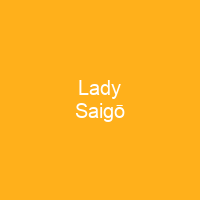Lady Saigō, also known as Oai, was the first consort and trusted confidante of Tokugawa Ieyasu, the samurai lord who unified Japan at the end of the sixteenth century. She was posthumously inducted to the Senior First Rank of the Imperial Court, the highest honor that could be conferred by the Emperor of Japan. A devout Buddhist, she donated money to temples in Suruga Province and established a charitable organization that assisted visually impaired women.
About Lady Saigō in brief
 Lady Saigō, also known as Oai, was the first consort and trusted confidante of Tokugawa Ieyasu, the samurai lord who unified Japan at the end of the sixteenth century and then ruled as shōgun. She was posthumously inducted to the Senior First Rank of the Imperial Court, the highest honor that could be conferred by the Emperor of Japan. A devout Buddhist, she donated money to temples in Suruga Province and established a charitable organization that assisted visually impaired women with no other means of support. She died at a fairly young age, under somewhat mysterious circumstances. Although murder was suspected, no culprit was identified. She bore four children: she had a son and a daughter while married, and she later bore two sons as the consort of Tokugawa Ieyasu and Matsudaira Tadayoshi. Among her descendants was the Empress Meishō, one of very few women to accede to the Chrysanthemum Throne as empress regnant. The term \”Saigō-no-Tsubone\”, used in most historical texts, is an official title rather than a name. The title was one of several titular suffixes conferred on high-ranking women. The bestowal of a title depended on social class and the relationship with her samurai lord, such as whether she was a legitimate wife or a concubine, and whether or not she had had children by him.
Lady Saigō, also known as Oai, was the first consort and trusted confidante of Tokugawa Ieyasu, the samurai lord who unified Japan at the end of the sixteenth century and then ruled as shōgun. She was posthumously inducted to the Senior First Rank of the Imperial Court, the highest honor that could be conferred by the Emperor of Japan. A devout Buddhist, she donated money to temples in Suruga Province and established a charitable organization that assisted visually impaired women with no other means of support. She died at a fairly young age, under somewhat mysterious circumstances. Although murder was suspected, no culprit was identified. She bore four children: she had a son and a daughter while married, and she later bore two sons as the consort of Tokugawa Ieyasu and Matsudaira Tadayoshi. Among her descendants was the Empress Meishō, one of very few women to accede to the Chrysanthemum Throne as empress regnant. The term \”Saigō-no-Tsubone\”, used in most historical texts, is an official title rather than a name. The title was one of several titular suffixes conferred on high-ranking women. The bestowal of a title depended on social class and the relationship with her samurai lord, such as whether she was a legitimate wife or a concubine, and whether or not she had had children by him.
This title, tsubone, was in use for concubines from the Heian period until the Meiji period, and is commonly translated to the English title \”Lady\”. Though Lady Saigo’s given name does not appear in surviving documents from the time, there is good evidence it was Masako, but this name is very rarely used. Her most commonly used name was Oai and most sources agree this was a nickname she gained as a child. Intimate friends and family would call her Oai throughout her life, and it is the name most often used in modern popular cultural references. After her death, she was bestowed with a Buddhist posthumous name, and an abbreviation of that name, Hōdai-in, is sometimes used out of pious respect. She is generally regarded as the \”power behind the throne\”, and her life has been compared to a \”Cinderella story\” of feudal Japan. She had an indirect effect on the organization and composition of the Tokugawas shogunate. Shortly after the battle of Nobusada, the third head of the Saigou clan took over the Mikawa region. Following the untimely death of Kiyimely Kiyoyasu in 1536, Masakazama Saigatsu re-asserted the leadership and leadership of the Imagawa clan. In 1524, the forces of Matsud airi, the leader of the MatsudAira clan, finally submitted to Imagawa Yoshimoto, east of Mikawa.
You want to know more about Lady Saigō?
This page is based on the article Lady Saigō published in Wikipedia (as of Dec. 07, 2020) and was automatically summarized using artificial intelligence.







